Easy Thai Red Curry Paste (Authentic Recipe)
Want restaurant-quality Thai curries at home? Homemade authentic Thai red curry paste is your answer. With a few Asian ingredients, a small food processor, and perseverance, you’ll have a flavourful curry paste for all your homemade Thai dishes.
Nothing beats the rich, complex flavours of an authentic Thai red curry. And it all starts with the aromatic and fiery red curry paste.
And, with just a few fresh ingredients and a food processor, you can make your own red curry paste at home!
Not only is it easy, but homemade curry pastes also taste fresher and more vibrant than store-bought options. So, why not give this easy Thai red curry paste recipe a try?
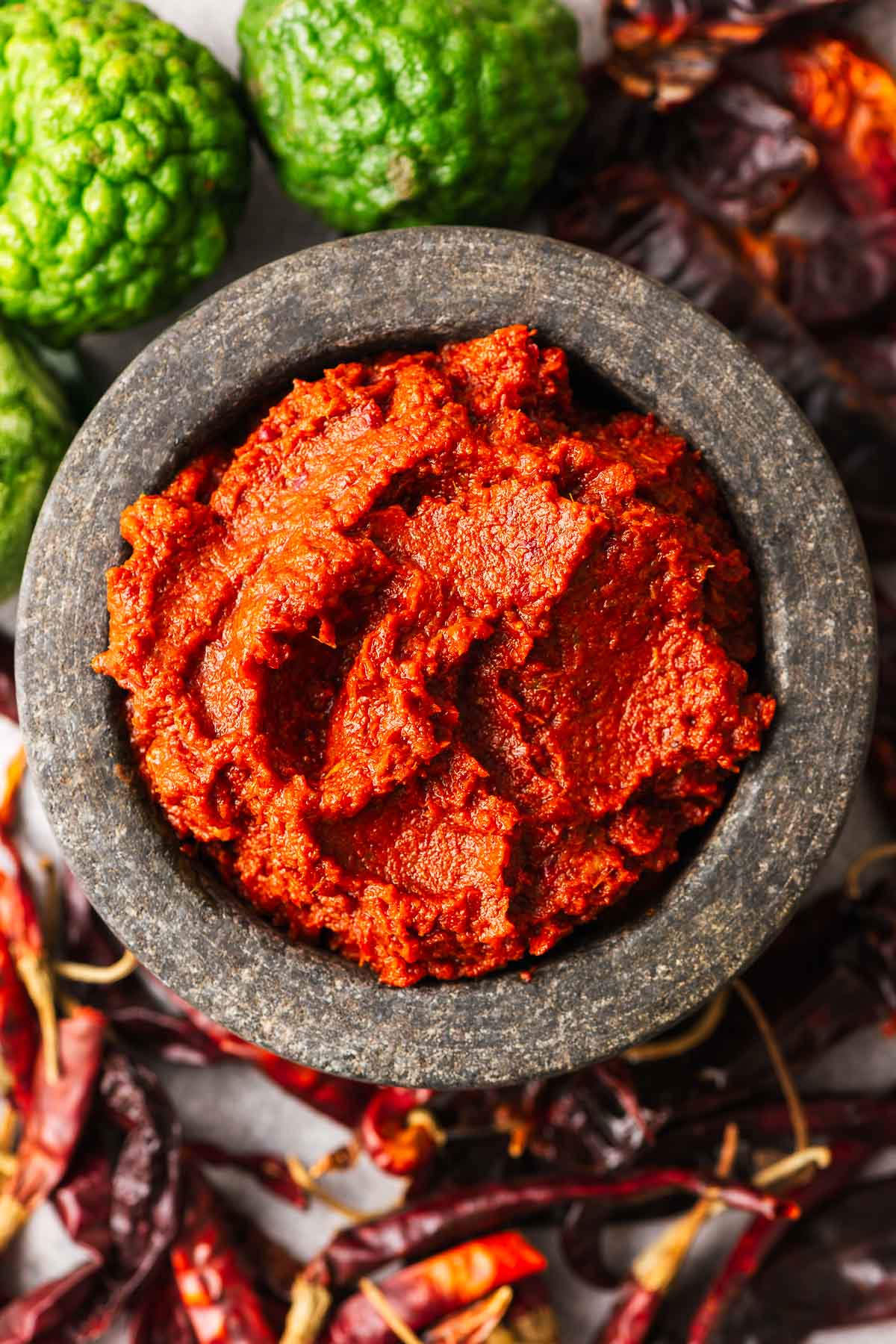
Why I love this recipe
- Authentic flavours: This homemade Thai red curry paste is packed with traditional Thai flavours from ingredients like lemongrass, galangal, and kaffir lime zest (makrut lime zest).
- Versatile: Use red curry paste in your favourite Thai recipes, from flavourful curries and marinades to Thai fish cakes.
- Easy to make: With my simple method for making authentic Thai curry paste you can get away with only using one kitchen appliance and no arduous pounding in the pestle and mortar.
- Long-lasting: This homemade Thai red curry paste can be stored in the fridge or freezer for future use, making it a convenient and essential ingredient for any Thai cooking enthusiast.
If you love Thai food as much as I do, you’re sure to love this homemade curry paste!
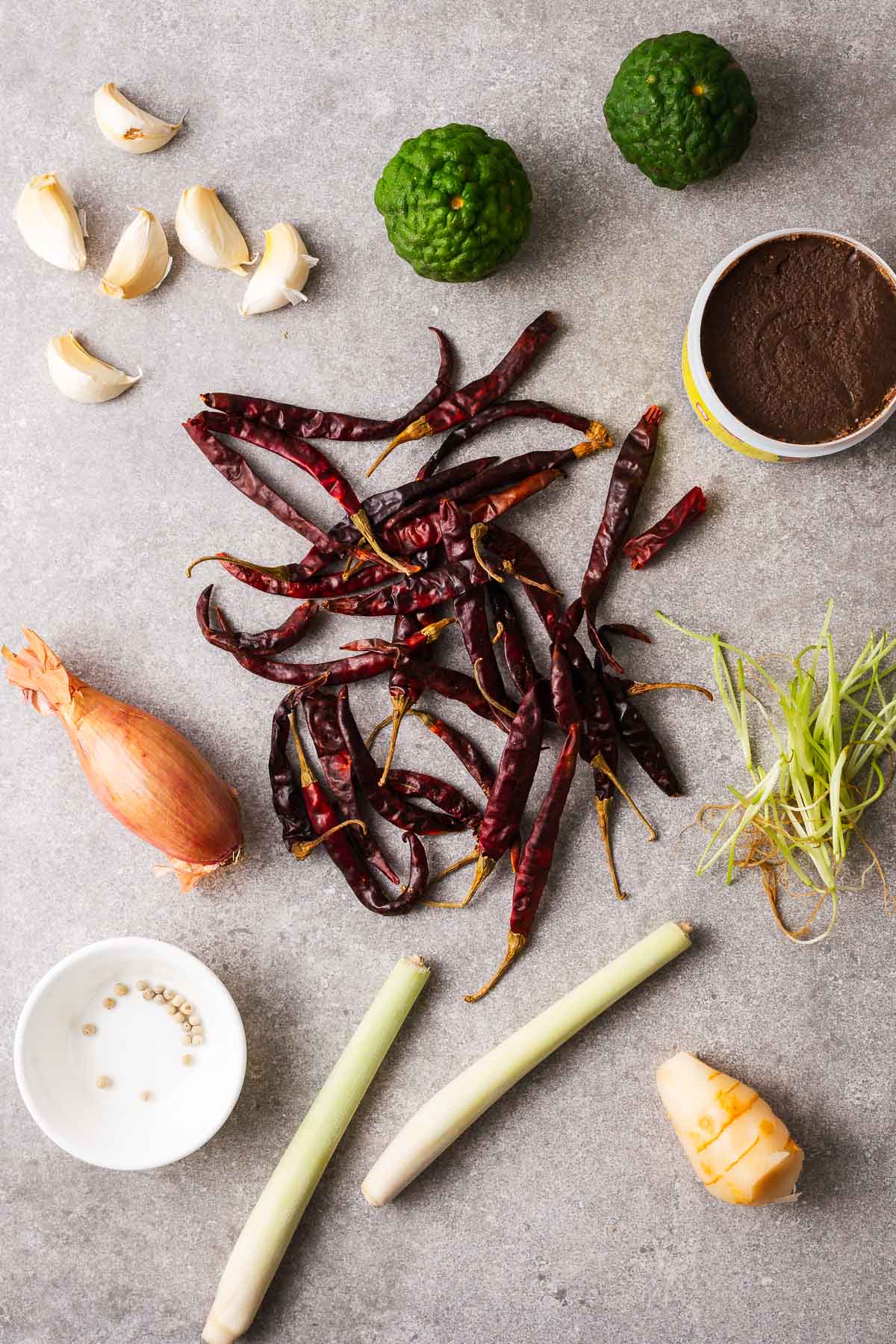
Ingredients and substitutes
While Thai red curry paste is easy to make, you will need a few key Thai ingredients. Most of these you’ll find in Asian markets or grocery stores. But I suggest plenty of substitutes so you can make the best Thai red curry paste with what you have.
- Dried chiles: The type of dried chilli you use will determine the spiciness of your curry paste. I use deseeded chile de arbol, but you can also use Thai red spur or generic dried red chillies from the Asian grocery store. Try guajillo if you want a milder paste.
- White peppercorns: You can also use black peppercorns.
- Galangal or ginger: Galangal is a traditional ingredient in curry paste. If you can’t find fresh galangal, you can use pickled galangal (in salt). Or substitute it with fresh ginger. Just don’t use dried galangal or galangal powder.
- Lemongrass: This is another staple ingredient in Thai cooking and adds a bright, lemony flavour to the paste.
- Shallots and garlic
- Cilantro root (coriander root): I use young cilantro roots and stems, but if you can’t find a bunch of cilantro with roots attached, just use the soft, light part of the stem.
- Makrut lime zest (kaffir lime zest): This adds a unique and essential citrusy flavour to the paste. If you can’t find makrut limes, you can substitute it with regular lime zest. Or add fresh kaffir lime leaves to simmer in your curry sauce when using the paste.
- Thai shrimp paste: This is a fermented seafood product. On its own, it is pungent! But in the curry paste it adds a savoury umami flavour. Swap for miso paste if you need a vegan curry paste.
- Salt
Some recipes also add coriander seeds and cumin seeds. You can add a teaspoon each when you add the peppercorns, but I prefer it without.
How to make Thai red curry paste
Here’s a step-by-step guide with pictures on how to make an authentic Thai red curry paste to add the most amazing and delicious flavour to your Thai dishes.
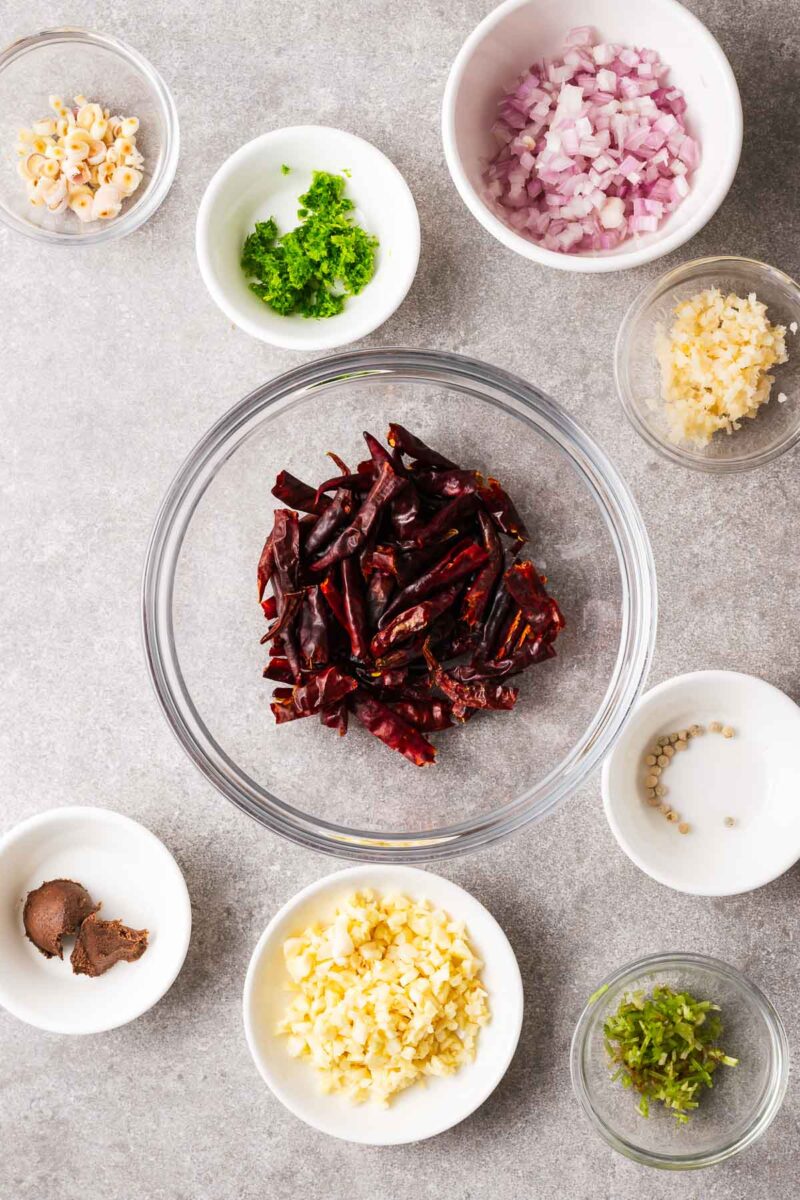

Step 1: Prep your ingredients according to the recipe instructions. The smaller you dice the ingredients, especially the hardy ones like galangal and lemongrass, the easier it is to create a smooth curry paste.
Step 2: Destem the dried chillies, break them in two, and shake out as many seeds and membranes as possible. This reduces the spiciness and makes it easier to blend. Place the chillies in a heat-proof bowl and cover them with boiling water. Let them soak for 30 minutes.
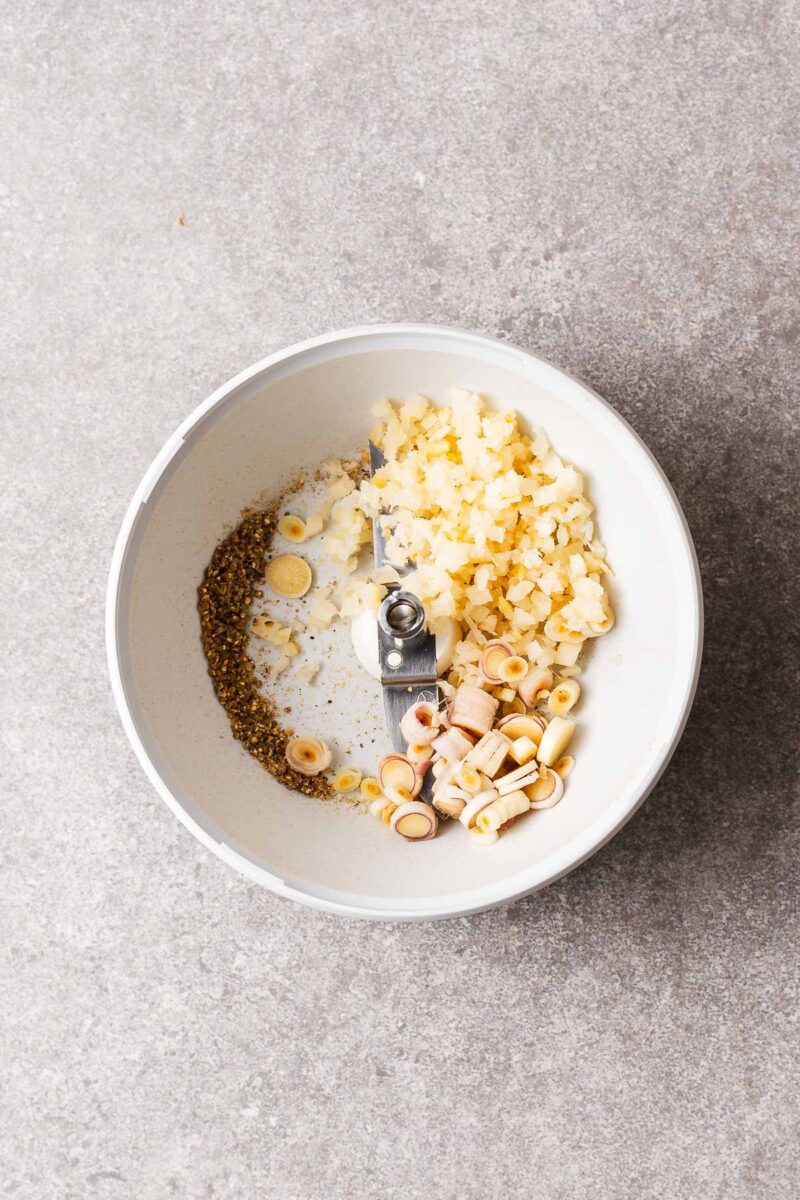

Step 3: In a small food processor or spice grinder, pulse the white peppercorns until they are coarsely ground. Add the diced galangal and sliced lemongrass to the grinder. Blend until you have a fibrous yet homogeneous blend. Be sure to scrape down the sides as needed.
Step 4: Add the diced shallot, garlic, and cilantro root (or stem) to the grinder and blend until you have a smooth, wet paste. Again, scrape down the sides and mix as needed.
If you use cilantro stems or young and soft cilantro roots (coriander roots), you can add them after the chillies in step six.
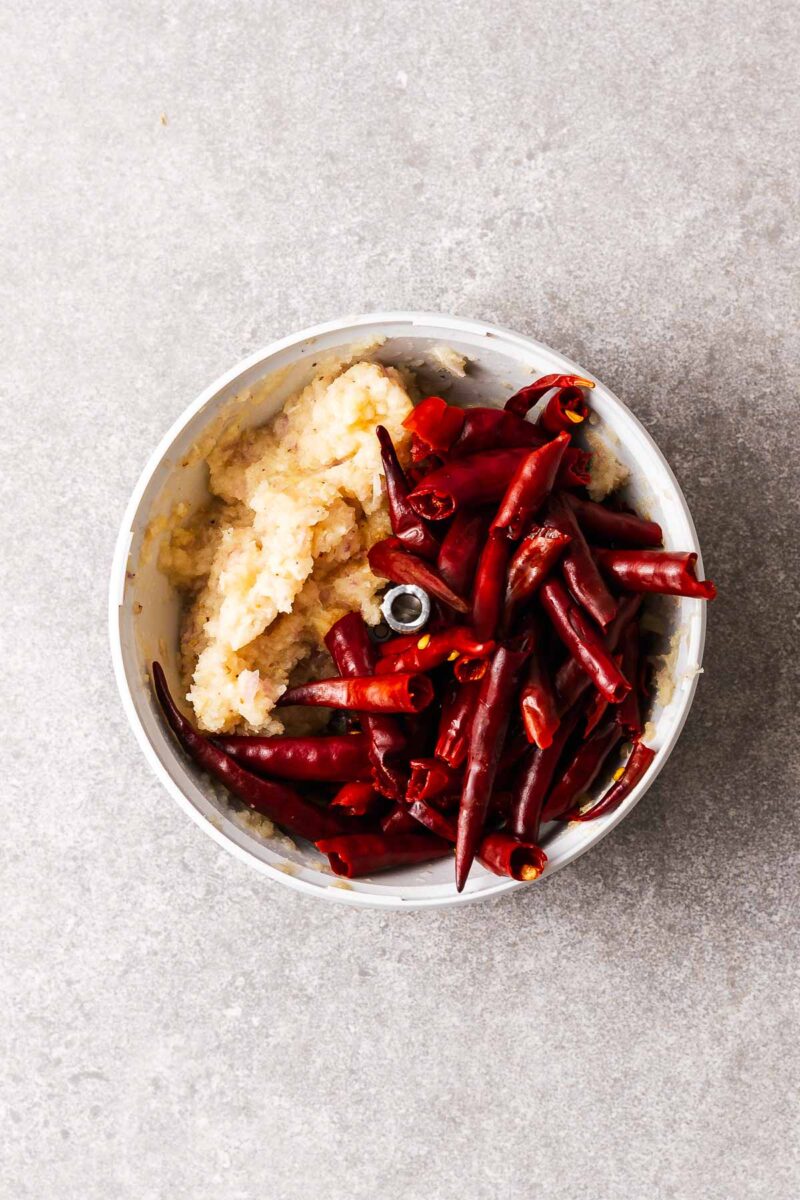
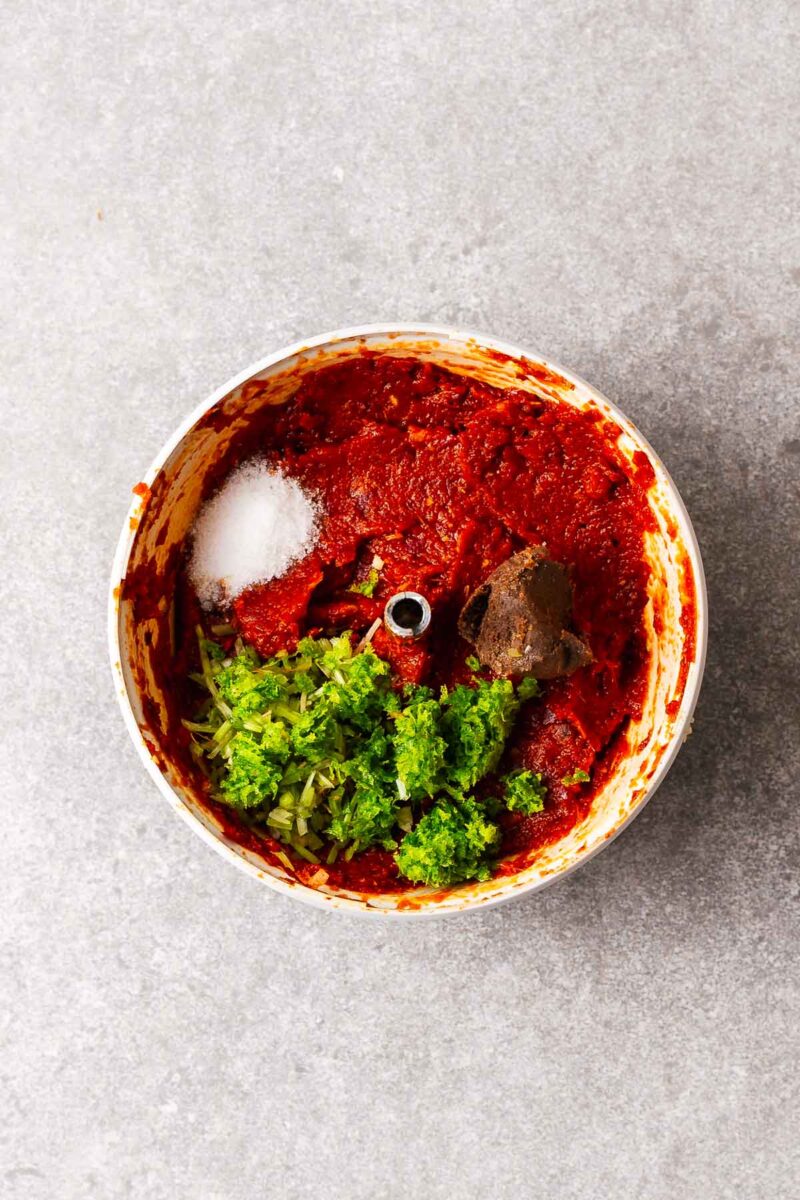
Step 5: Drain the chillies and add them to the food processor, in batches if necessary. Continue blending until you have a smooth, bright red paste.
Step 6: Finally, add the remaining ingredients and blend until you have a smooth, thick red paste.
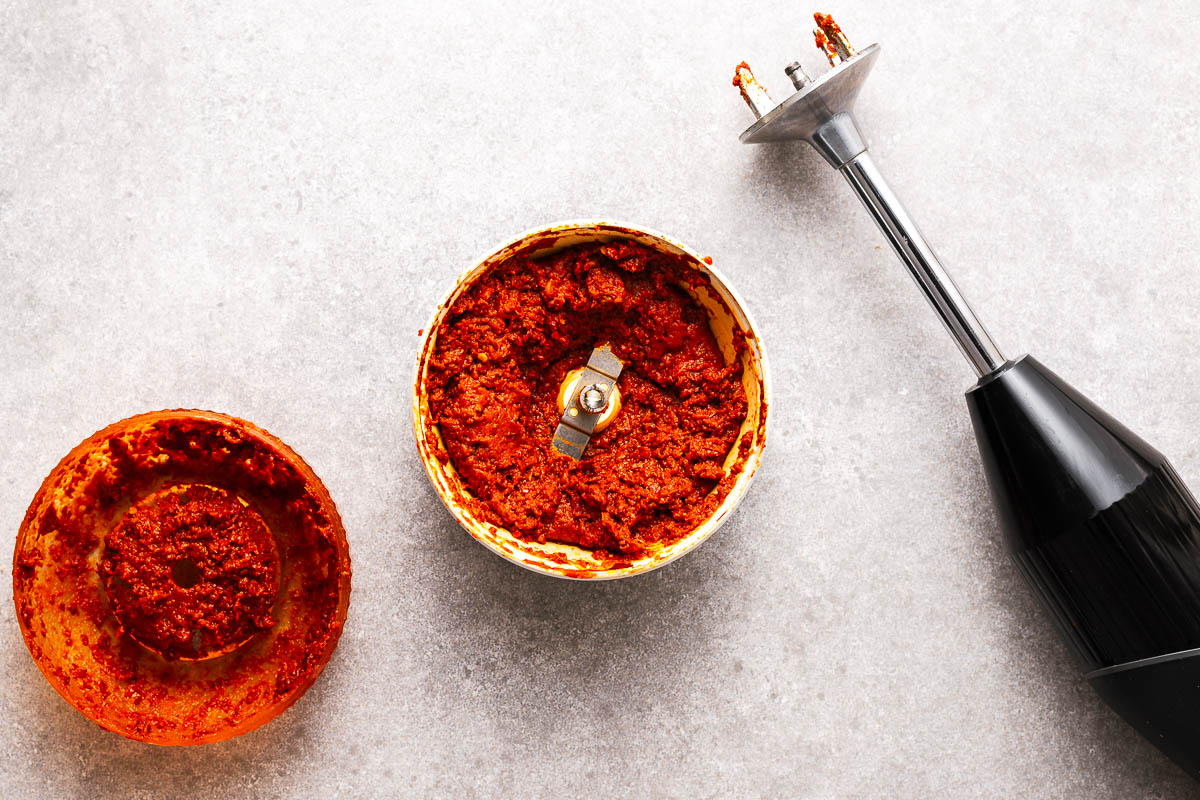
Storage
Refrigerate the curry paste in an airtight container for up to 5 days. Alternatively, you can freeze it in portions for up to 3 months.
The recipe creates 150 grams (roughly half a cup) of curry paste. This is enough to make 12 servings of Thai curry. So, I like to split the curry paste into 3 portions when freezing.
How to use
Authentic Thai red curry recipe: Use your homemade red curry paste in a traditional Thai red curry recipe. Simply stir-fry the curry paste in oil. Then combine with coconut milk, fish sauce, and palm sugar (or brown sugar). Cook your choice of protein (chicken, beef, fish, shrimp, tofu), and vegetables (like red bell peppers, bamboo shoots, or eggplant) in the curry sauce. And, serve over jasmine rice for a complete Thai meal.
Try this fish Thai red curry recipe.
Spice up your stir-fries: Add a spoonful of this red curry paste to your stir-fries and noodle dishes for a burst of flavour and heat.
Marinade: Mix curry paste with soy sauce, fish sauce and a squeeze of lime juice for a delicious easy marinade for meat.
Add flavour to meatballs: Draw inspiration from chicken in pandan leaf and traditional Thai fish cakes, and add a spoonful of curry paste to your favourite meatballs.
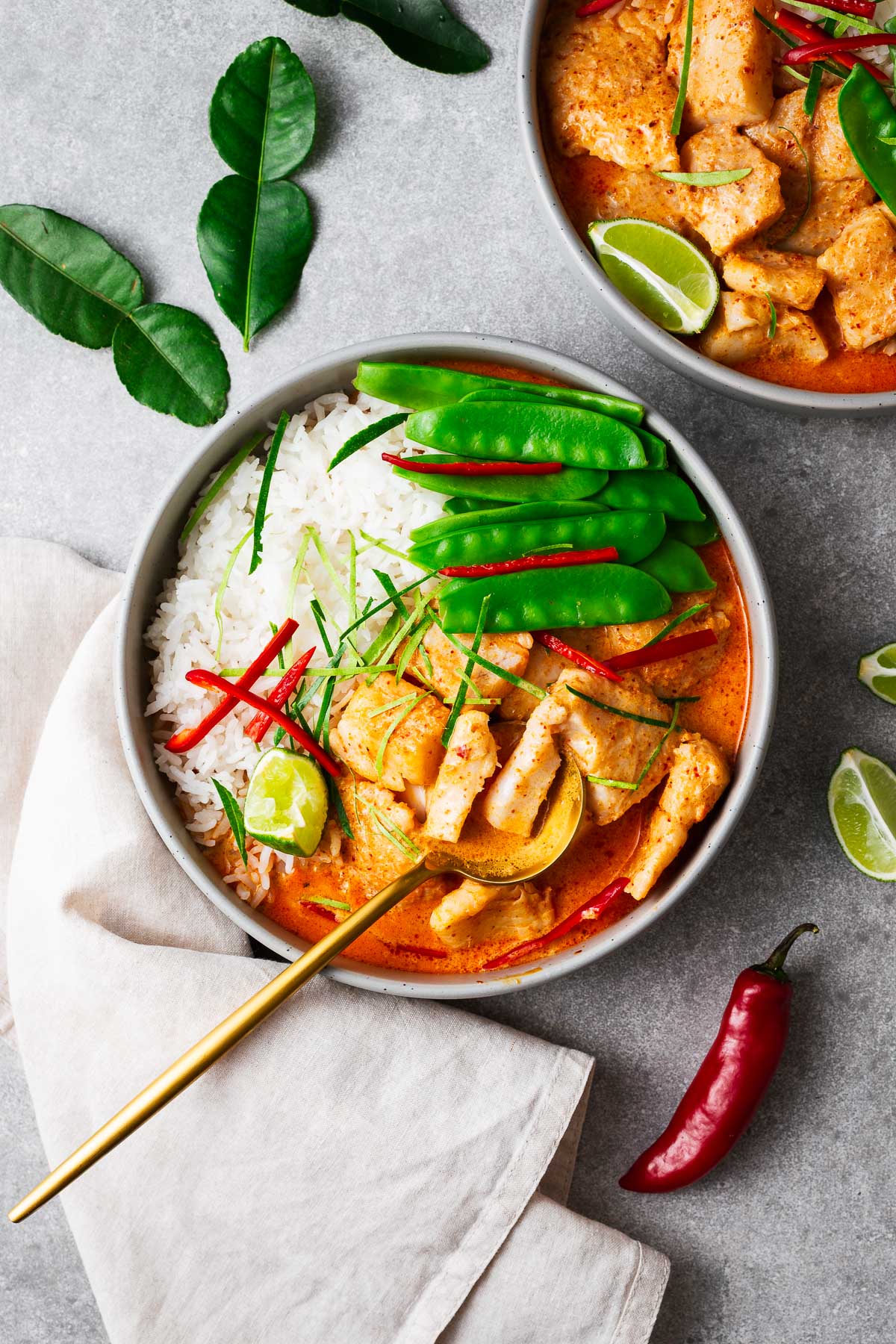
Frequently asked questions
Red Thai curry paste is made from red chillies, garlic, shallots, lemongrass, galangal, Thai shrimp paste, and kaffir lime peel. The exact ingredients may vary slightly depending on the brand and recipe. Some recipes also include cumin and coriander seeds.
Red curry paste is a versatile ingredient used in many Thai dishes. It is most commonly used as a base for red Thai curries. But, it is also a popular ingredient in Thai stir-fries, marinades, soups, and even salad dressings.
Thai red curry paste is generally quite spicy, but the level of heat varies depending on the brand or recipe. If you prefer a milder flavour, you can adjust the amount of curry paste you use or mix it with coconut milk to tone down the spiciness.
Thai red curry paste typically contains shrimp paste, galangal, lemongrass and kaffir lime peel while Indian red curry paste often includes tomato paste, vinegar, and spices like cumin, coriander, and turmeric. Both curry pastes contain dried chillies, garlic and shallots.
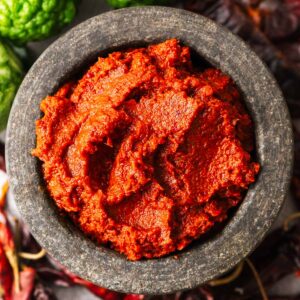
Ingredients
- 30 dried chiles de arbol *
- 20 white peppercorns , or black
- 1 tablespoon finely diced galangal * , or ginger
- 2 stalks lemongrass , tough outer leaves and base removed, then finely sliced
- ¼ cup finely diced shallot , about 1 small shallot
- 6 cloves garlic , peeled
- 1 tablespoon sliced cilantro roots , or stems
- 2 teaspoons finely grated makrut lime zest *
- 2 teaspoons shrimp paste
- 1 teaspoon salt
Instructions
- Destem the chillies, break them in two, and shake out as many seeds and membranes as possible – this reduces the spiciness and makes it easier to blend. Place the chillies in a heat-proof bowl and cover with boiling water. Leave to soak for 30 minutes.
- Add the peppercorns to a small food processor or spice grinder and pulse until coarsely ground.
- Add the diced galangal and sliced lemongrass. Blitz until you have a fibrous yet homogeneous blend, scraping down the sides as needed.
- Add the diced shallot, garlic, and cilantro root (or stem). Blitz until you have a wet, mostly smooth, paste. Stop to scrape down the sides and mix as needed.
- Drain the chillies and add them to the grinder – in batches if needed. Blitz until you have a smooth, bright red paste.
- Add the remaining ingredients and blend into a smooth, thick red paste.
- Refrigerate the curry paste in an airtight container for up to 5 days or freeze in portions for up to 3 months.
Notes
- The type of dried chilli determines the spiciness of your curry paste. The traditional choice is dried Thai red spur chillies – but they’re not readily available. Instead, I use deseeded chile de arbol. The generic dried red chillies from Asian grocery stores also work well. Or, opt for dried guajillo for a milder chilli paste.
- If you can’t find fresh or brine-pickled galangal, use fresh ginger instead.
- limes (also called kaffir limes) are green wrinkly limes used in Thai cuisine. A single lime is typically enough for 2 teaspoons (10 grams) of kaffir lime zest.
- The authentic Thai curry paste method requires a pestle and mortar but requires lots of arm strength and patience. Instead, I use the small food processor/spice grinder attached to my Bamix immersion blender and add the ingredients in batches. You can use a spice grinder, small food processor or high-speed blender. But if you use a standard-sized food processor, you’ll need to double the recipe.
- To make Thai red curry, stir-fry your authentic red curry paste in oil, then add coconut milk, fish sauce, and palm sugar. Cook your veggies or meat in the fragrant curry sauce. See my Thai fish curry recipe for step-by-step instructions.

The Thai red curry paste was a game-changer! Bursting with flavor, it adds a kick to any Thai dish.
I couldn’t agree more, Vicky! It’s just so flavourful!
I made stir fry last night and added this curry paste. WOW! Was just what the recipe needed, so tasty!
I’m so happy you enjoyed it, Paula! It’s definitely one of my favourite Thai flavours too!